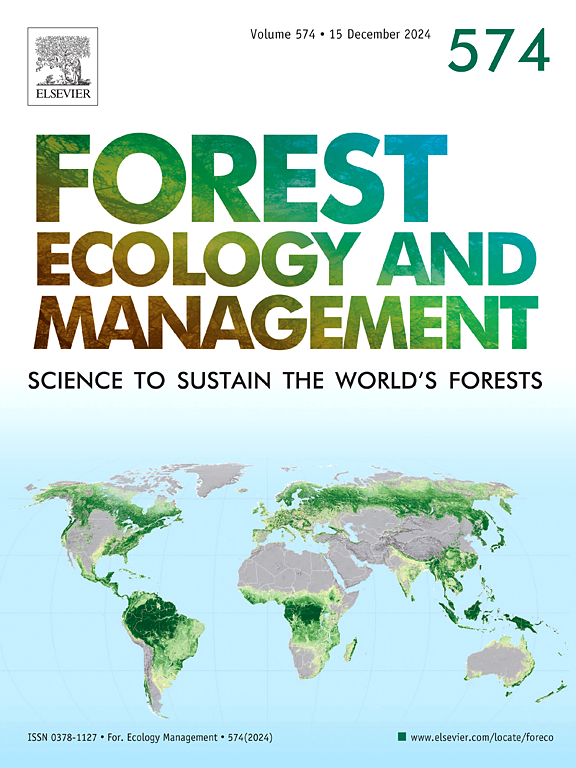利用遥感在辅助基因流情景中区分密切相关的山毛榉物种
IF 3.7
2区 农林科学
Q1 FORESTRY
引用次数: 0
摘要
欧洲山毛榉(Fagus sylvatica L.)森林正遭受日益严重和频繁的干旱。来自保加利亚、小亚细亚、高加索和伊朗的密切相关的山毛榉物种为适应性森林管理策略提供了遗传资源,如辅助迁移(AM)和辅助基因流动(AGF),以增强气候适应。然而,由于相似的形态和叶色,以及在某些情况下的杂交,跟踪从这些相关物种引进的山毛榉基因型的命运是具有挑战性的。传统的识别方法依赖于详细的形态评估和基因测试,这是一种劳动密集型和昂贵的方法,不适合大规模应用。本研究评估了高分辨率遥感对杂交山毛榉物种分类和监测的潜力。利用PlanetScope SuperDove的多光谱数据,我们开发了一种遥感分类方法,捕捉欧洲山毛榉(F. sylvatica)和共生高加索山毛榉(Fagus hohenackeriana Palibin)之间的物候差异,这两个物种能够杂交。我们的方法通过关注关键的时间窗和光谱特征来优化分类性能。我们对来自法国和瑞士两个研究充分的地点的200多名基因分类个体的数据进行了分层时空交叉验证,评估了各种机器学习算法。一个多世纪前,法国和瑞士引入了高加索山毛榉。这种方法在德国的三个不同的研究区域进行了进一步的测试,在那里,高加索山毛榉也种植在一个已知的地区,但没有单独的树木坐标。关键结果表明,我们的方法揭示了春季和秋季明显的时间和光谱差异,对应于发芽和衰老。大多数算法的分类准确率在90 %以上。该算法有效地确定了高加索山毛榉候选区域内或附近的区域由当地林业员指出。这项研究展示了高分辨率多光谱卫星图像和机器学习在高加索山毛榉被引入欧洲山毛榉森林的多个地点对两种密切相关的山毛榉物种进行分类的潜力。这种分类在生长季节的开始或结束时最准确,可能是由于物候差异。通过利用遥感技术,我们为AGF和AM情景下树种引进的大规模跟踪提供了概念证明,为利用地球观测数据进行适应性森林管理提供了有价值的工具。本文章由计算机程序翻译,如有差异,请以英文原文为准。
Leveraging remote sensing to distinguish closely related beech species in assisted gene flow scenarios
European beech (Fagus sylvatica L.) forests are suffering under increasingly severe and frequent drought. Closely related beech species from Bulgaria, Asia Minor, the Caucasus, and Iran offer genetic resources for adaptive forest management strategies such as assisted migration (AM) and assisted gene flow (AGF) to enhance climate adaptation. However, due to similar morphology and leaf color, as well as hybridization in some cases, it is challenging to track the fate of introduced beech genotypes from these related species. Traditional identification methods relying on detailed morphological assessments and genetic testing are labor-intensive and costly, making them impractical for large-scale applications. This study evaluates the potential of high-resolution remote sensing to classify and monitor hybridizing beech species. Using multispectral data from PlanetScope SuperDove, we developed a remote sensing classification approach that captures phenological differences between the European beech F. sylvatica and co-planted Caucasian beech (Fagus hohenackeriana Palibin), two species capable of hybridization. Our method optimizes classification performance by focusing on key temporal windows and spectral features. We evaluated various machine learning algorithms with stratified spatial and temporal cross-validation on data from over 200 genetically classified individuals in two well-studied sites in France and Switzerland, where Caucasian beech was introduced over a century ago. The approach was further tested on three different study areas in Germany, where Caucasian beech was also planted in a known region but without individual tree coordinates. Key results show that our approach reveals distinct temporal and spectral differences during spring and autumn, corresponding with budbreak and senescence. Most algorithms achieved classification accuracies above 90 %. The algorithms effectively identified candidate zones for Caucasian beech within or near areas indicated by local foresters. This study demonstrates the potential of high-resolution multispectral satellite imagery and machine learning for classifying two closely related beech species in multiple locations where Caucasian beech was introduced to European beech forests. This classification is most accurate at the beginning or end of the growing season, likely due to phenological differences. By leveraging remote sensing, we provide a proof of concept for large-scale tracking of tree species introduction in AGF and AM scenarios, offering a valuable tool for adaptive forest management using Earth observation data.
求助全文
通过发布文献求助,成功后即可免费获取论文全文。
去求助
来源期刊

Forest Ecology and Management
农林科学-林学
CiteScore
7.50
自引率
10.80%
发文量
665
审稿时长
39 days
期刊介绍:
Forest Ecology and Management publishes scientific articles linking forest ecology with forest management, focusing on the application of biological, ecological and social knowledge to the management and conservation of plantations and natural forests. The scope of the journal includes all forest ecosystems of the world.
A peer-review process ensures the quality and international interest of the manuscripts accepted for publication. The journal encourages communication between scientists in disparate fields who share a common interest in ecology and forest management, bridging the gap between research workers and forest managers.
We encourage submission of papers that will have the strongest interest and value to the Journal''s international readership. Some key features of papers with strong interest include:
1. Clear connections between the ecology and management of forests;
2. Novel ideas or approaches to important challenges in forest ecology and management;
3. Studies that address a population of interest beyond the scale of single research sites, Three key points in the design of forest experiments, Forest Ecology and Management 255 (2008) 2022-2023);
4. Review Articles on timely, important topics. Authors are welcome to contact one of the editors to discuss the suitability of a potential review manuscript.
The Journal encourages proposals for special issues examining important areas of forest ecology and management. Potential guest editors should contact any of the Editors to begin discussions about topics, potential papers, and other details.
 求助内容:
求助内容: 应助结果提醒方式:
应助结果提醒方式:


